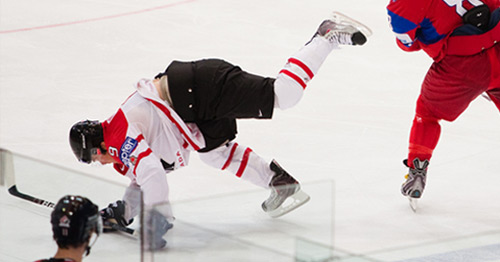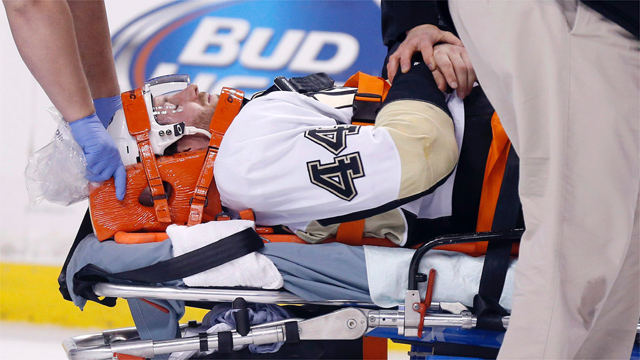Ice Hockey Injuries! Ice hockey injuries are common due to the sport’s physical nature. Players often suffer from concussions, fractures, and sprains.
Ice hockey is a fast-paced and physically demanding sport that can lead to various injuries. Players often experience concussions due to collisions and falls on the ice. Fractures, particularly of the wrist and collarbone, are also frequent. Sprains and strains occur from sudden movements and overuse of muscles.
Protective gear helps reduce the risk, but injuries remain a significant concern. Understanding common injuries and preventive measures is crucial for players. Proper training, equipment, and awareness can help minimize the risk and ensure a safer playing environment.

Credit: www.hss.edu
Common Ice Hockey Injuries
Ice hockey is a thrilling sport. It is also very fast-paced. Players face many physical risks. Injuries are common in this sport. Understanding these injuries is important. It helps in prevention and treatment.
Head And Neck Injuries
Head and neck injuries are serious in ice hockey. Concussions are a major concern. They occur due to hard hits or falls. Players may experience headaches, dizziness, and confusion. Neck strains and sprains are common. They happen during collisions or awkward falls.
Prevention Tips:
- Wear a well-fitted helmet.
- Use a neck guard for extra protection.
- Practice safe checking techniques.
Shoulder And Arm Injuries
Shoulder and arm injuries are frequent. Dislocations and fractures can occur. These injuries often happen during contact with other players or the boards. Shoulder separations are also common. They can be very painful and limit arm movement.
Prevention Tips:, but it also
- Strengthen shoulder muscles through exercises.
- Wear protective padding on shoulders and arms.
- Avoid direct hits to the boards.
Knee And Leg Injuries
Knee and leg injuries can sideline a player for weeks. Sprains and strains are very common. They happen during sudden stops or direction changes. Ligament tears, like ACL injuries, are severe and require long recovery periods.
Prevention Tips:
- Wear knee braces if needed.
- Strengthen leg muscles with regular exercises.
- Practice proper skating techniques.
Risk Factors
Ice hockey is a thrilling sport. But it comes with risks. Understanding the risk factors can help players stay safe.
Age And Experience
Age and experience play a big role in ice hockey injuries. Younger players often lack the skills to avoid injuries. Older players may suffer from wear and tear.
Beginners are more likely to get hurt. They might not know how to fall safely. Experienced players can also get injured. They might take more risks on the ice.
Playing Position
Different positions in ice hockey have different risks. Forwards often get checked more. This can lead to injuries like concussions.
Defensemen block shots. This puts their bodies at risk of bruises and fractures. Goalies face flying pucks. They need to be quick to avoid injuries.
| Position | Common Injuries |
|---|---|
| Forwards | Concussions, shoulder injuries |
| Defensemen | Bruises, fractures |
| Goalies | Knee injuries, puck impacts |
Equipment And Gear
Wearing the right equipment and gear is crucial. Ill-fitting gear can lead to injuries.
- Helmets protect the head from concussions.
- Shoulder pads guard against collisions.
- Gloves protect the hands from sticks and pucks.
Always check your gear before playing. Make sure everything fits well. Replace worn-out equipment promptly.
Protective Gear
Ice hockey is an exciting and fast-paced sport. But it also comes with a high risk of injuries. Wearing the right protective gear can significantly reduce these risks. This section will cover essential protective gear, including helmets, padding, and proper footwear.
Helmets And Face Shields
Helmets are crucial for preventing head injuries. A good helmet will absorb impacts and protect your skull. Face shields are also important. They guard your face from pucks and sticks. A helmet with a face shield can prevent broken noses and lost teeth.
- Helmet fit: Make sure the helmet fits snugly.
- Face shield: Choose between full and half shields.
- Chin straps: Always secure the chin strap tightly.
Padding And Guards
Pads and guards protect your body from hits and falls. Key pieces of padding include shoulder pads, elbow pads, and shin guards. Shoulder pads shield your collarbones and shoulders. Elbow pads protect your elbows and forearms. Shin guards keep your shins and knees safe.
| Protective Gear | Body Part Protected |
|---|---|
| Shoulder Pads | Collarbones and Shoulders |
| Elbow Pads | Elbows and Forearms |
| Shin Guards | Shins and Knees |
Proper Footwear
Wearing proper footwear is essential in ice hockey. Hockey skates should fit well and provide ankle support. Skates that are too loose can cause ankle injuries. Tight skates can lead to blisters and discomfort. Make sure your skates are the right size and fit for you.
- Fit: Ensure skates fit snugly but are not too tight.
- Ankle support: Look for skates with good ankle support.
- Comfort: Choose skates that are comfortable to wear.
Warm-up Routines
Ice hockey is fast and intense. Warm-up routines are crucial to prevent injuries. Players need to prepare their muscles and joints before hitting the ice. A proper warm-up enhances performance and reduces the risk of injuries.
Stretching Exercises
Stretching is essential for flexibility. It prepares muscles for action. Here are some effective stretches:
- Hamstring Stretch: Sit on the ground. Extend one leg. Reach for your toes.
- Quad Stretch: Stand. Pull one foot to your buttock. Hold for 15 seconds.
- Hip Flexor Stretch: Kneel on one knee. Push your hips forward.
Strengthening Drills
Strengthening drills build muscle endurance. They help support joints and prevent strains. Key strengthening exercises include:
- Squats: Stand with feet shoulder-width apart. Lower your body. Keep your back straight.
- Lunges: Step forward with one leg. Lower your hips. Keep your back straight.
- Planks: Hold a push-up position. Keep your body straight. Hold for 30 seconds.
Cardio And Endurance
Cardio exercises boost heart health. They improve endurance on the ice. Effective cardio routines include:
| Exercise | Duration |
|---|---|
| Jumping Jacks | 5 minutes |
| High Knees | 3 minutes |
| Running | 10 minutes |
Combining these warm-up routines ensures players are ready. It reduces the chance of ice hockey injuries.
On-ice Safety Practices
Ice hockey is a thrilling and fast-paced sport. It also has its risks. Understanding on-ice safety practices can help reduce injuries. Players need to know the right techniques and communication methods. Let’s explore some key safety practices.
Checking Techniques
Proper checking techniques are crucial in ice hockey. They help avoid injuries. Players should always keep their heads up. This prevents head and neck injuries. Using the body’s center of gravity is important. It ensures balance and control.
- Keep your head up.
- Use your body’s center of gravity.
- Avoid hitting from behind.
Safe Skating
Safe skating is another key aspect. Players should wear the right gear. Helmets, pads, and mouthguards are essential. Skating with knees slightly bent helps with balance. It also allows for quick movements.
- Wear proper gear.
- Keep knees slightly bent.
- Maintain a low center of gravity.
Communication With Teammates
Communication with teammates is vital. Good communication prevents collisions. Players should call out plays. They should also alert teammates of their positions. This keeps everyone aware and safe.
| Communication Tips | Benefits |
|---|---|
| Call out plays | Prevents confusion |
| Alert teammates of positions | Avoids collisions |
| Use hand signals | Improves clarity |
Immediate Injury Response
Ice hockey is a thrilling sport but can lead to injuries. Knowing the right steps to take immediately can reduce the severity of injuries and speed up recovery.
First Aid Basics
Understanding basic first aid is crucial for managing ice hockey injuries. Here are key steps:
- Stop the game immediately if someone is hurt.
- Assess the injured player for bleeding, swelling, or deformities.
- Apply ice to reduce swelling and numb the pain.
- Elevate the injured limb to minimize swelling.
- Use a compression bandage to control swelling and provide support.
When To Seek Medical Help
Some injuries need professional medical help. Seek help if you notice:
- Severe pain that does not improve with rest.
- Visible deformity or bone protrusion.
- Loss of consciousness or confusion.
- Severe bleeding that cannot be controlled.
Do not attempt to move the injured player if a spinal injury is suspected.
Handling Concussions
Concussions are common in ice hockey and need immediate attention:
- Remove the player from the game right away.
- Check for signs like headache, dizziness, or nausea.
- Monitor the player closely for changes in behavior.
- Avoid giving any medications without consulting a doctor.
- Seek medical help if symptoms worsen or do not improve.
Rest and gradual return to play are crucial for concussion recovery.
Rehabilitation And Recovery
Rehabilitation and recovery are crucial for ice hockey players. Injuries are common in this fast-paced sport. Proper recovery helps players return to the ice safely.
Physical Therapy
Physical therapy plays a vital role in recovery. Therapists create personalized plans for each player. These plans include exercises to strengthen injured areas.
Common treatments include:
- Stretching exercises
- Strength training
- Massage therapy
- Ice and heat application
Therapists monitor progress closely. They adjust plans as needed. This ensures players heal properly and prevent further injury.
Mental Health Support
Recovering from an injury is not just physical. Mental health support is equally important. Injured players often feel frustrated or anxious.
Support can include:
- Counseling sessions
- Support groups
- Mindfulness practices
Coaches and teammates should offer encouragement. A positive mindset speeds up recovery.
Nutrition And Hydration
Proper nutrition and hydration are essential during recovery. A balanced diet helps the body heal faster. Hydration keeps muscles and tissues healthy.
Important nutrients include:
- Protein for muscle repair
- Vitamins and minerals for overall health
- Carbohydrates for energy
Players should drink plenty of water. Staying hydrated aids in recovery and overall well-being.

Credit: www.youtube.com
Preventive Measures
Preventing injuries in ice hockey is crucial. Players need to be healthy and safe. Proper care and training can help avoid many injuries.
Regular Medical Check-ups
Regular medical check-ups are vital for all players. They help detect early signs of health issues. Doctors can provide advice to prevent injuries.
- Annual physical exams
- Pre-season health assessments
- Regular monitoring of chronic conditions
Conditioning Programs
Conditioning programs build strength and endurance. Strong muscles support joints and bones. Good conditioning reduces the risk of injuries.
| Type | Benefits |
|---|---|
| Strength Training | Improves muscle power |
| Cardio Exercises | Increases stamina |
| Flexibility Workouts | Enhances range of motion |
Educating Players And Coaches
Educating players and coaches is essential. They need to understand safety protocols. Proper techniques can prevent many injuries.
- Teach safe playing techniques
- Promote the use of protective gear
- Encourage open communication about health

Credit: www.sportsnet.ca
Frequently Asked Questions
What Are Common Ice Hockey Injuries?
Common ice hockey injuries include concussions, fractures, sprains, and muscle strains. These injuries often result from high-speed collisions and falls on the ice.
How Can Ice Hockey Injuries Be Prevented?
Ice hockey injuries can be prevented by wearing proper protective gear. Additionally, practicing good technique and following safety guidelines are essential.
What Should You Do After An Ice Hockey Injury?
After an ice hockey injury, rest and seek medical evaluation. Follow the healthcare provider’s advice for recovery and rehabilitation.
Are Concussions Frequent In Ice Hockey?
Yes, concussions are frequent in ice hockey due to physical contact. Wearing a helmet and following safety rules can help reduce the risk.
Conclusion
Ice hockey can be thrilling but comes with injury risks. Proper gear and safety measures are essential. Always stay vigilant and proactive about your health. Understanding common injuries helps in prevention and quicker recovery. Prioritize safety to enjoy the game longer and avoid setbacks.
Stay safe and keep skating!




